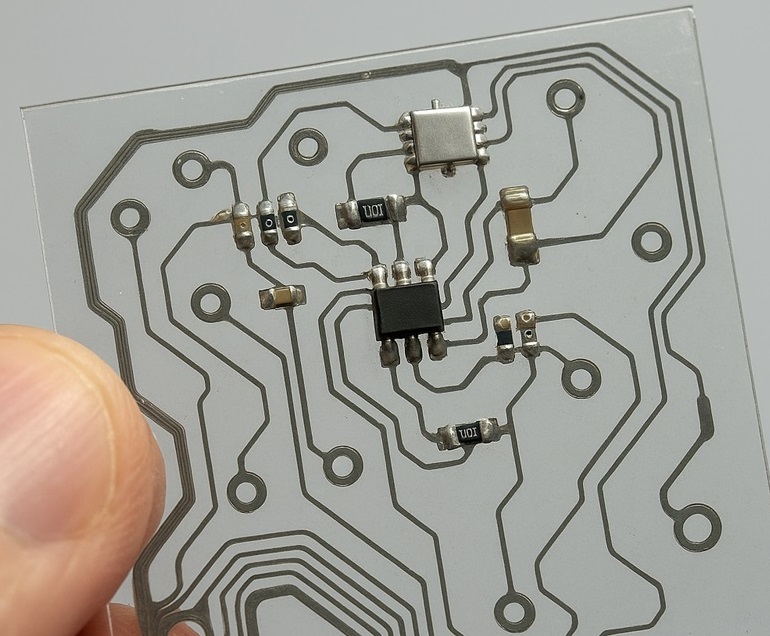As electronic design shifts toward experience and aesthetics, traditional opaque circuit boards can no longer meet the needs of modern, visually integrated products. Transparent pcbs, made from materials like glass, PET, or transparent polyimide, offer both functionality and visual clarity—allowing light transmission and visible circuitry—making them an ideal choice for next-generation devices.
Common Materials for Transparent PCBs
The transparency of transparent pcbs lies in the base materials used. They are primarily divided into glass-based transparent PCBs and polymer-based (flexible) transparent PCBs. During manufacturing, the copper traces are typically made extremely fine, and some designs may use transparent conductive materials such as conductive silver paste or transparent conductive films to maximize visual effects.

transparent pcb
Glass-based transparent PCBs are made from ultra-thin or flexible glass, offering excellent optical transparency, good heat resistance, dimensional stability, and strong moisture/oxygen resistance. They are fragile (but less so when using UTG), heavier than plastic, less flexible (except for specialty glass), and more expensive. They are best suited for high-precision applications requiring extremely high stability, such as display backplanes and rigid transparent structures.
Polymer-based flexible PCBs made from materials such as PET, PEN, PC, and CPI offer flexibility, lightweight design, shatter resistance, and cost-effectiveness, making them suitable for foldable smartphones, rollable displays, wearable devices, and curved electronics. However, these PCBs have poor heat resistance, are prone to warping due to temperature or humidity, and have inferior barrier properties compared to glass, limiting their use to low-temperature applications.
Applications of Transparent PCBs
The applications of transparent pcbs go far beyond simply “looking cool.” They are increasingly being adopted in new types of electronic products, particularly in the following areas:
1. Consumer Electronics
Electronic products used in daily life are popular due to their compact size and ease of integration. Smartwatches, smartphones, and smart devices are all equipped with displays that have transparent or semi-transparent properties. These displays are transparent when inactive and become functional during use. Therefore, transparent pcbs are indispensable in these applications. The internal circuit layout is invisible and inaccessible to the end-user.
2. Transparent Display Devices
In transparent displays, transparent pcbs are essential. Devices and components requiring seamless integration with transparent screens must maintain an aesthetically pleasing form factor alongside supporting electronic PCBs. Many signage, content display units, and video walls utilize transparent PCBs and their various features to enhance the user experience.
3. Medical visualization devices
In some precision diagnostic devices (such as otoscopes, nasopharyngoscopes, etc.), due to extremely limited space, it is often necessary to integrate functions such as lighting, signal acquisition, and micro-sensors into transparent housings or probes. Traditional PCBs have obvious limitations in terms of size and light blocking, while transparent pcbs can simultaneously serve as both conductive and optical pathways.
Advantages of Transparent PCBs
-Enhanced Product Aesthetics: Transparent pcbs offer a visually appealing appearance, enabling innovative and attractive designs, particularly in products where aesthetics are critical.
-Support for Optical Design: In applications involving light transmission or optical components (e.g., LED lighting systems), transparent PCBs allow light to pass through unobstructed, thereby enhancing functionality.
-High Flexibility: Rigid, flexible, or rigid-flex versions can be selected to accommodate different structural requirements.
Challenges in Manufacturing Transparent PCBs
-Manufacturing Complexity: Transparent PCBs may require specialized manufacturing processes and materials, increasing production costs and complexity.
-Signal Integrity Challenges: Transparent materials may have different dielectric properties, leading to signal integrity challenges such as impedance mismatch or signal distortion.
-Limited Availability: Transparent pcb substrates may not be as readily available or standardized as traditional materials, limiting options and increasing costs.
-Durability issues: Some transparent materials may not be as robust or durable as traditional PCB substrates, potentially affecting the lifespan and reliability of the circuit board.
Conclusion
Transparent pcbs have strong development potential in the near future. As materials improve and manufacturing challenges are overcome, they are increasingly being used in real-world applications and will continue to expand into more demanding environments.